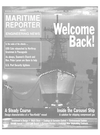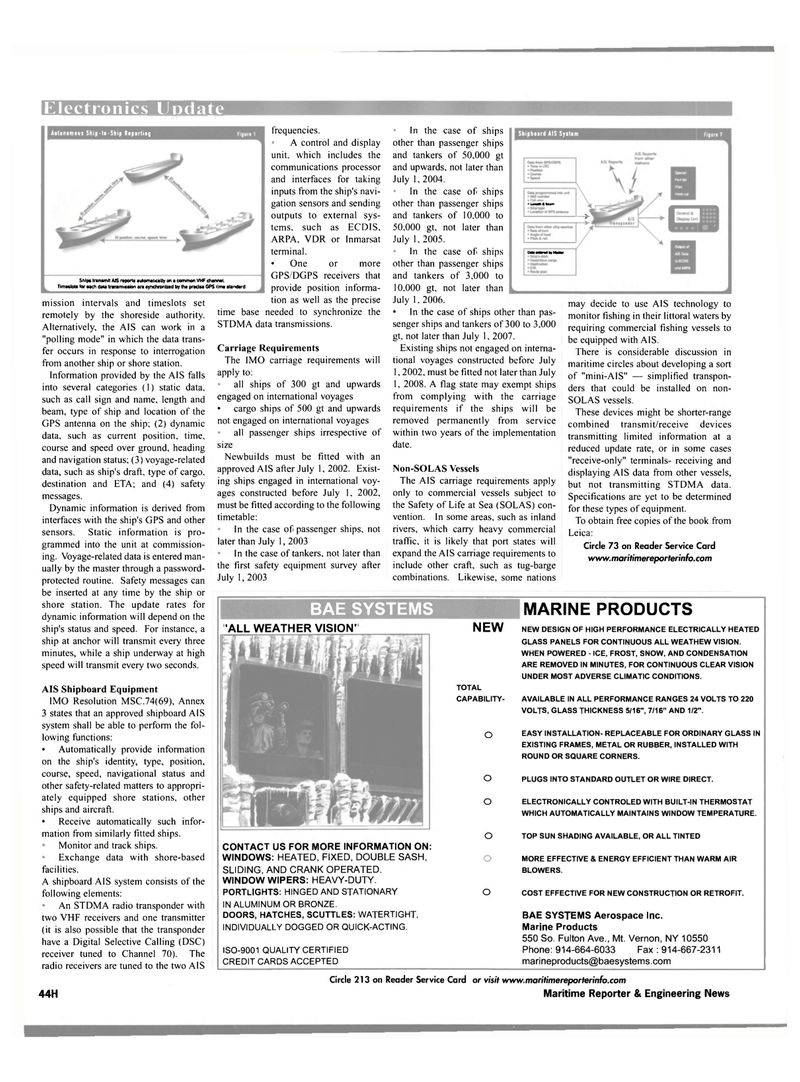
Page 52: of Maritime Reporter Magazine (October 2001)
Read this page in Pdf, Flash or Html5 edition of October 2001 Maritime Reporter Magazine
Electronics Update
Autonomous Ship-to-Ship Reporting
Slip* transmit AIS roports automatical^ on a common VHP charrol
Tirntslots for aach dso transmission ara synchnxiizad by tha pracisa GPS lima standard mission intervals and timeslots set remotely by the shoreside authority.
Alternatively, the AIS can work in a "polling mode" in which the data trans- fer occurs in response to interrogation from another ship or shore station.
Information provided by the AIS falls into several categories (1) static data, such as call sign and name, length and beam, type of ship and location of the
GPS antenna on the ship; (2) dynamic data, such as current position, time, course and speed over ground, heading and navigation status; (3) voyage-related data, such as ship's draft, type of cargo, destination and ETA; and (4) safety messages.
Dynamic information is derived from interfaces with the ship's GPS and other sensors. Static information is pro- grammed into the unit at commission- ing. Voyage-related data is entered man- ually by the master through a password- protected routine. Safety messages can be inserted at any time by the ship or shore station. The update rates for dynamic information will depend on the ship's status and speed. For instance, a ship at anchor will transmit every three minutes, while a ship underway at high speed will transmit every two seconds.
AIS Shipboard Equipment
IMO Resolution MSC.74(69), Annex 3 states that an approved shipboard AIS system shall be able to perform the fol- lowing functions: • Automatically provide information on the ship's identity, type, position, course, speed, navigational status and other safety-related matters to appropri- ately equipped shore stations, other ships and aircraft. • Receive automatically such infor- mation from similarly fitted ships.
Monitor and track ships.
Exchange data with shore-based facilities.
A shipboard AIS system consists of the following elements:
An STDMA radio transponder with two VHF receivers and one transmitter (it is also possible that the transponder have a Digital Selective Calling (DSC) receiver tuned to Channel 70). The radio receivers are tuned to the two AIS 44H frequencies.
A control and display unit, which includes the communications processor and interfaces for taking inputs from the ship's navi- gation sensors and sending outputs to external sys- tems, such as ECDIS,
ARPA, VDR or Inmarsat terminal. • One or more
GPS/DGPS receivers that provide position informa- tion as well as the precise time base needed to synchronize the
STDMA data transmissions.
Carriage Requirements
The IMO carriage requirements will apply to: all ships of 300 gt and upwards engaged on international voyages • cargo ships of 500 gt and upwards not engaged on international voyages all passenger ships irrespective of size
Newbuilds must be fitted with an approved AIS after July 1,2002. Exist- ing ships engaged in international voy- ages constructed before July 1, 2002, must be fitted according to the following timetable:
In the case of passenger ships, not later than July 1, 2003
In the case of tankers, not later than the first safety equipment survey after
July 1, 2003
Shipboard AIS System • A b»*m •
OMMnfUiaw,
In the case of ships other than passenger ships and tankers of 50,000 gt and upwards, not later than
July 1, 2004.
In the case of ships other than passenger ships and tankers of 10,000 to 50,000 gt, not later than
July 1, 2005.
In the case of ships other than passenger ships and tankers of 3,000 to 10,000 gt, not later than
July 1, 2006. • In the case of ships other than pas- senger ships and tankers of 300 to 3,000 gt, not later than July 1, 2007.
Existing ships not engaged on interna- tional voyages constructed before July 1, 2002, must be fitted not later than July 1, 2008. A flag state may exempt ships from complying with the carriage requirements if the ships will be removed permanently from service within two years of the implementation date.
Non-SOLAS Vessels
The AIS carriage requirements apply only to commercial vessels subject to the Safety of Life at Sea (SOLAS) con- vention. In some areas, such as inland rivers, which carry heavy commercial traffic, it is likely that port states will expand the AIS carriage requirements to include other craft, such as tug-barge combinations. Likewise, some nations may decide to use AIS technology to monitor fishing in their littoral waters by requiring commercial fishing vessels to be equipped with AIS.
There is considerable discussion in maritime circles about developing a sort of "mini-AIS" — simplified transpon- ders that could be installed on non-
SOLAS vessels.
These devices might be shorter-range combined transmit/receive devices transmitting limited information at a reduced update rate, or in some cases "receive-only" terminals- receiving and displaying AIS data from other vessels, but not transmitting STDMA data.
Specifications are yet to be determined for these types of equipment.
To obtain free copies of the book from
Leica:
Circle 73 on Reader Service Card www.maritimereporterinfo.com
BAE SYSTEMS MARINE PRODUCTS 'ALL WEATHER VISION' NEW
TOTAL
CAPABILITY- o
CONTACT US FOR MORE INFORMATION ON:
WINDOWS: HEATED, FIXED, DOUBLE SASH,
SLIDING, AND CRANK OPERATED.
WINDOW WIPERS: HEAVY-DUTY.
PORTLIGHTS: HINGED AND STATIONARY
IN ALUMINUM OR BRONZE.
DOORS, HATCHES, SCUTTLES: WATERTIGHT,
INDIVIDUALLY DOGGED OR QUICK-ACTING.
ISO-9001 QUALITY CERTIFIED
CREDIT CARDS ACCEPTED
O
O
O
O
NEW DESIGN OF HIGH PERFORMANCE ELECTRICALLY HEATED
GLASS PANELS FOR CONTINUOUS ALL WEATHEW VISION.
WHEN POWERED - ICE, FROST, SNOW, AND CONDENSATION
ARE REMOVED IN MINUTES, FOR CONTINUOUS CLEAR VISION
UNDER MOST ADVERSE CLIMATIC CONDITIONS.
AVAILABLE IN ALL PERFORMANCE RANGES 24 VOLTS TO 220
VOLTS, GLASS THICKNESS 5/16", 7/16" AND 1/2".
EASY INSTALLATION- REPLACEABLE FOR ORDINARY GLASS IN
EXISTING FRAMES, METAL OR RUBBER, INSTALLED WITH
ROUND OR SQUARE CORNERS.
PLUGS INTO STANDARD OUTLET OR WIRE DIRECT.
ELECTRONICALLY CONTROLED WITH BUILT-IN THERMOSTAT
WHICH AUTOMATICALLY MAINTAINS WINDOW TEMPERATURE.
TOP SUN SHADING AVAILABLE, OR ALL TINTED
MORE EFFECTIVE & ENERGY EFFICIENT THAN WARM AIR
BLOWERS.
COST EFFECTIVE FOR NEW CONSTRUCTION OR RETROFIT.
BAE SYSTEMS Aerospace Inc.
Marine Products 550 So. Fulton Ave., Mt. Vernon, NY 10550
Phone: 914-664-6033 Fax : 914-667-2311 [email protected]
Circle 213 on Reader Service Card or visit www.maritimereporterinfo.com
Maritime Reporter & Engineering News

 51
51

 53
53
